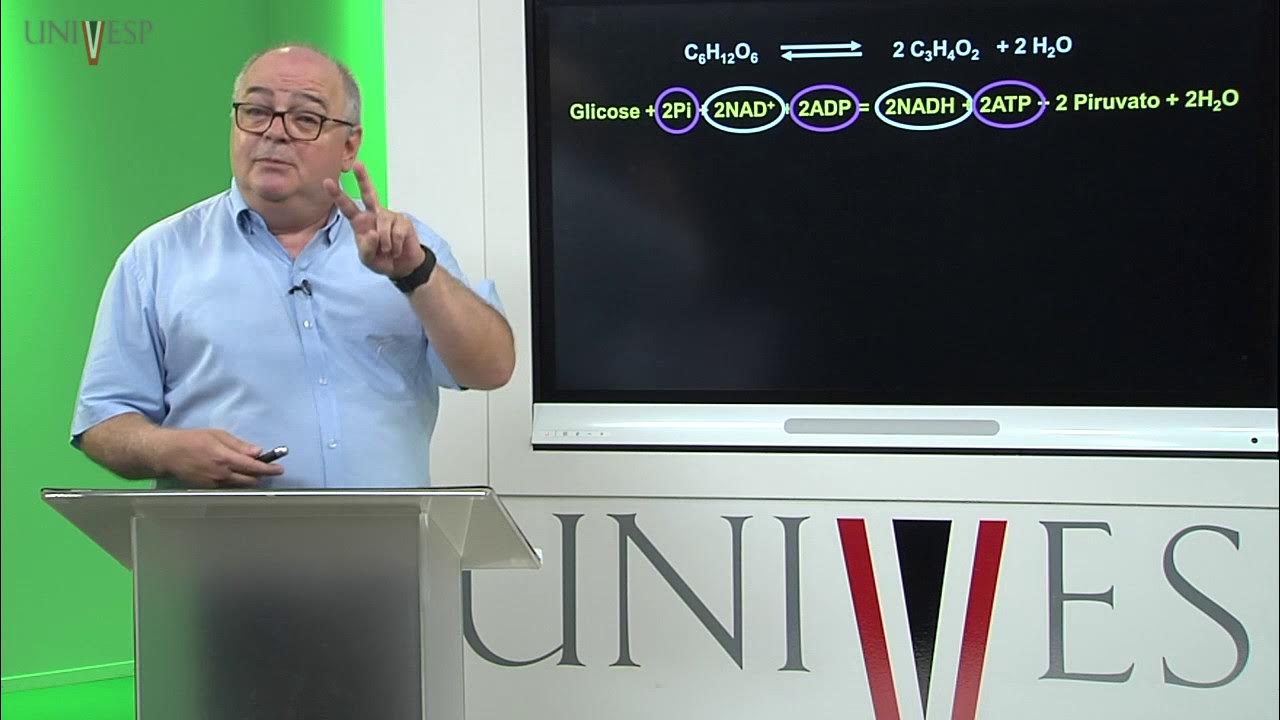Bioquímica - Aula 06 - Enzimas (Parte 2)
Summary
TLDRIn this biochemistry lecture, Professor Ângelo Cortel dives into the role of enzymes, focusing on their active sites and the critical amino acids involved in catalysis. He explains key concepts such as protonation and deprotonation of amino acids and their impact on enzyme function. The lecture covers enzyme kinetics, including the Michaelis-Menten equation, and the effects of enzyme concentration on reaction rates. The professor also explores enzyme inhibition, differentiating between irreversible and reversible inhibitors. To conclude, an exercise is proposed to calculate the maximum activity and Km of an intestinal peptidase enzyme, using experimental data and Michaelis-Menten graphs.
Takeaways
- 😀 Enzymes have an active site that often contains amino acids or ions capable of donating or receiving protons, which are crucial for catalysis.
- 😀 Common amino acids like lysine, arginine, histidine, aspartic acid, and glutamic acid are often found in active sites due to their ability to protonate or deprotonate.
- 😀 Histidine, with its nitrogen group, can deprotonate and plays a key role in enzyme catalysis.
- 😀 The mechanism of chymotrypsin catalysis involves serine and histidine, where histidine attracts a proton, allowing the serine oxygen to break peptide bonds.
- 😀 In ester hydrolysis, histidine in the enzyme active site interacts with water molecules to break the ester bond, producing an alcohol and an acid.
- 😀 Enzyme reaction speed increases with substrate concentration until it reaches a maximum (Vmax), where all active sites are saturated.
- 😀 The Michaelis-Menten equation describes the relationship between enzyme speed and substrate concentration, with Km being a key value for enzyme-substrate affinity.
- 😀 The Michaelis-Menten constant (Km) reflects how tightly an enzyme binds to its substrate; lower Km means a higher affinity.
- 😀 Inhibition of enzyme activity can occur through irreversible or reversible inhibitors. Irreversible inhibitors permanently inactivate enzymes, while reversible inhibitors temporarily affect enzyme activity.
- 😀 Competitive inhibition occurs when an inhibitor competes with the substrate for the enzyme's active site, while non-competitive inhibition affects enzyme activity regardless of substrate binding.
- 😀 Understanding enzyme kinetics and inhibition is important for regulating biochemical processes, with applications in drug development and metabolism control.
Q & A
What is the primary function of the active site in enzymes?
-The active site of an enzyme is where the substrate binds, and it typically contains amino acids or ions that help catalyze the reaction. These amino acids can donate or accept protons, influencing the enzyme's ability to interact with substrates.
Why are certain amino acids commonly found in the active site of enzymes?
-Certain amino acids like lysine, arginine, histidine, aspartic acid, glutamate, cysteine, and serine are common in enzyme active sites because they can donate or accept protons, which is essential for the catalytic process. Their ability to change based on pH helps facilitate enzymatic reactions.
How does the pH affect the enzyme’s active site?
-The pH affects the ionization state of amino acids in the active site. For example, at different pH levels, amino acids may be protonated or deprotonated, altering their ability to interact with the substrate and affecting the enzyme's catalytic efficiency.
What is the role of histidine in enzyme catalysis?
-Histidine in enzyme catalysis often acts as a proton donor or acceptor due to its imidazole group, which can be protonated or deprotonated depending on the pH. This ability allows histidine to participate in many enzymatic reactions, such as breaking peptide bonds.
What does the Michaelis-Menten equation describe?
-The Michaelis-Menten equation describes the relationship between the rate of an enzyme-catalyzed reaction and the concentration of substrate. It provides insights into enzyme kinetics, including the maximum reaction rate (Vmax) and the Michaelis constant (Km), which indicates the affinity of the enzyme for its substrate.
What is Km, and how is it related to enzyme activity?
-Km, the Michaelis constant, represents the substrate concentration at which the reaction rate is half of the maximum rate (Vmax). A lower Km indicates a higher affinity of the enzyme for the substrate, meaning the enzyme can achieve maximum activity at lower substrate concentrations.
How do inhibitors affect enzyme activity?
-Inhibitors reduce enzyme activity by either binding to the active site or interacting with the enzyme in other ways. Inhibitors can be irreversible, where they permanently deactivate the enzyme, or reversible, where they temporarily reduce enzyme activity.
What is the difference between competitive, non-competitive, and uncompetitive inhibition?
-Competitive inhibition occurs when an inhibitor competes with the substrate for binding at the active site. Non-competitive inhibition happens when an inhibitor binds to a site other than the active site, reducing the enzyme's activity. Uncompetitive inhibition involves the inhibitor binding to the enzyme-substrate complex, preventing product formation.
How does the Lineweaver-Burk plot help determine Km and Vmax?
-The Lineweaver-Burk plot is a double-reciprocal plot of the Michaelis-Menten equation. It linearizes the enzyme kinetics data, making it easier to determine Vmax (from the y-intercept) and Km (from the x-intercept) more accurately.
What is the significance of enzyme inhibition in biological systems?
-Enzyme inhibition plays a crucial role in regulating metabolic pathways. It helps control the rates of biochemical reactions, ensuring that enzymes are not overactive or underactive. Inhibitors can also be used in medicine to target specific enzymes, such as using antibiotics to inhibit bacterial enzymes or using pain relievers to block enzymes involved in inflammation.
Outlines

このセクションは有料ユーザー限定です。 アクセスするには、アップグレードをお願いします。
今すぐアップグレードMindmap

このセクションは有料ユーザー限定です。 アクセスするには、アップグレードをお願いします。
今すぐアップグレードKeywords

このセクションは有料ユーザー限定です。 アクセスするには、アップグレードをお願いします。
今すぐアップグレードHighlights

このセクションは有料ユーザー限定です。 アクセスするには、アップグレードをお願いします。
今すぐアップグレードTranscripts

このセクションは有料ユーザー限定です。 アクセスするには、アップグレードをお願いします。
今すぐアップグレード5.0 / 5 (0 votes)






